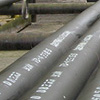

Hunan Standard Steel as a member of Husteel Industry Group, is a professional manufacturer of mild steel pipes and pipe fittings, which has a complete system of production... More
Factory GroupAnalysis of defects in thick - wall seamless tubes
Date:2017-06-28
Views:2328
Hierarchical defects from the mechanism, it is generally believed that non-metallic inclusions in the tube will destroy the continuity and compactness of steel, serious inclusions even in the steel pipe inside the stratification phenomenon. The other is considered hydrogen induced cracks, that is, due to the hydrogen accumulation in the steel caused by the metal internal gas partial pressure is too high, in the circular tube to form white spots in the rolling process of the expansion of the cracks, and ultimately the formation of layered defects. In addition, the non-uniform deformation of the two-roll oblique rolling perforations produces stress that exceeds the plastic strength and causes stratification.
In the case of strict control of smelting, the third case, the control measures are:
1, To improve the duct toughness
Improve the cleanliness of molten steel, reduce the harmful inclusions; increase the proportion of equiaxed billet, reduce the center segregation and center loose; use a reasonable cooling system to avoid internal cracks within the slab; Slow cooling process to reduce the internal stress, so as to ensure that the tube and finished pipe material and mechanical properties to meet the technical standards.
2, Reasonable control of heating temperature
By measuring the thermoplastic curve, select the optimum heating temperature. Tube heating should also pay attention to have enough insulation time to reduce the deformation resistance and improve the plastic toughness.
3, Reduce the roll speed
The roll speed is the key parameter of the piercing process, and there is a critical roll speed that begins to appear in the process of the roll speed from low to high. When the roll speed is low, the tube is easy to form the cavity; when the roll speed is high, the tube and the capillary are easy to form the stratification defect. In order to eliminate defects in the tube and capillary layers, the roll speed should be reduced below the critical roll speed at which the stratification begins to occur.
In the case of strict control of smelting, the third case, the control measures are:
1, To improve the duct toughness
Improve the cleanliness of molten steel, reduce the harmful inclusions; increase the proportion of equiaxed billet, reduce the center segregation and center loose; use a reasonable cooling system to avoid internal cracks within the slab; Slow cooling process to reduce the internal stress, so as to ensure that the tube and finished pipe material and mechanical properties to meet the technical standards.
2, Reasonable control of heating temperature
By measuring the thermoplastic curve, select the optimum heating temperature. Tube heating should also pay attention to have enough insulation time to reduce the deformation resistance and improve the plastic toughness.
3, Reduce the roll speed
The roll speed is the key parameter of the piercing process, and there is a critical roll speed that begins to appear in the process of the roll speed from low to high. When the roll speed is low, the tube is easy to form the cavity; when the roll speed is high, the tube and the capillary are easy to form the stratification defect. In order to eliminate defects in the tube and capillary layers, the roll speed should be reduced below the critical roll speed at which the stratification begins to occur.





















